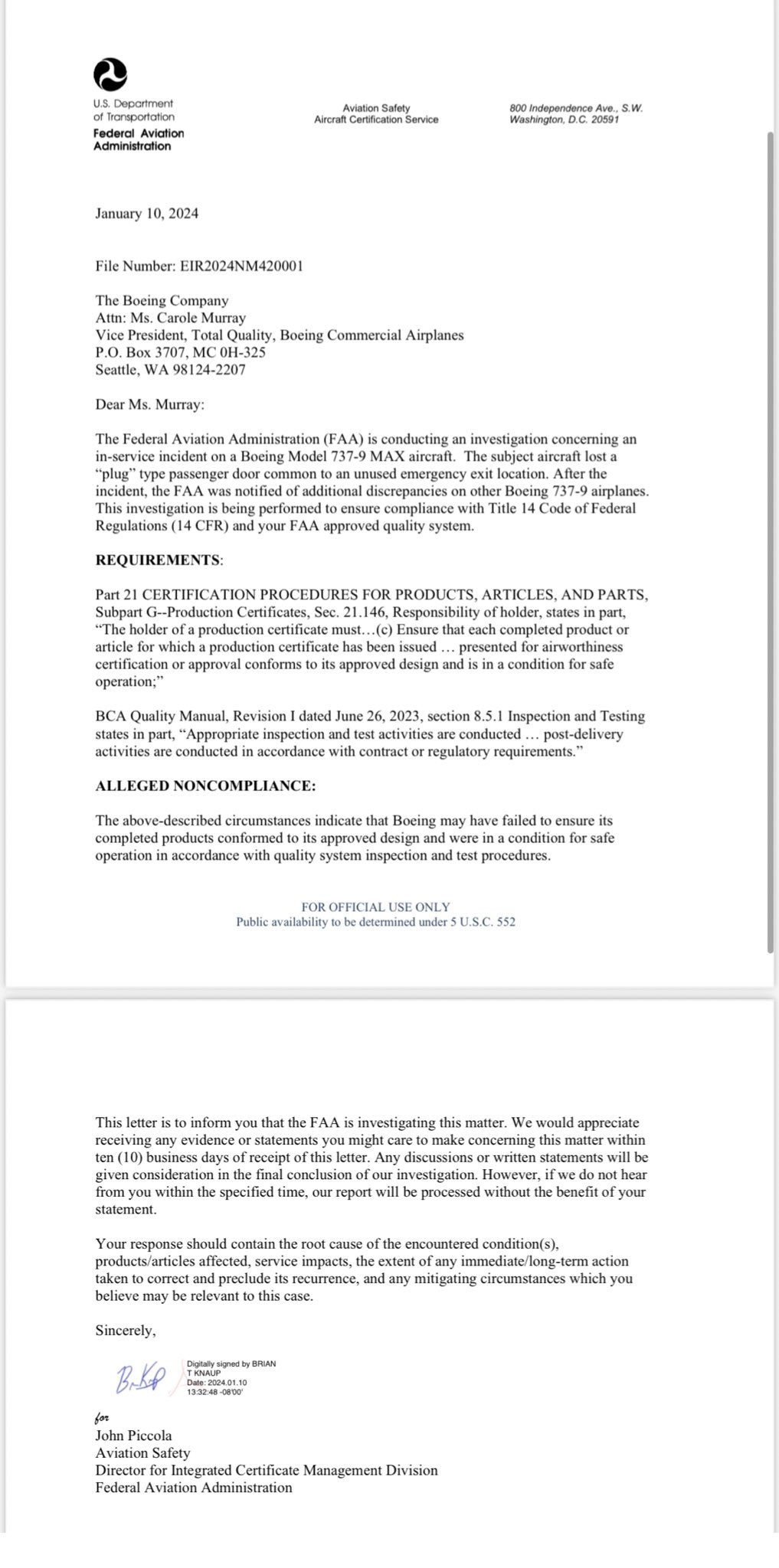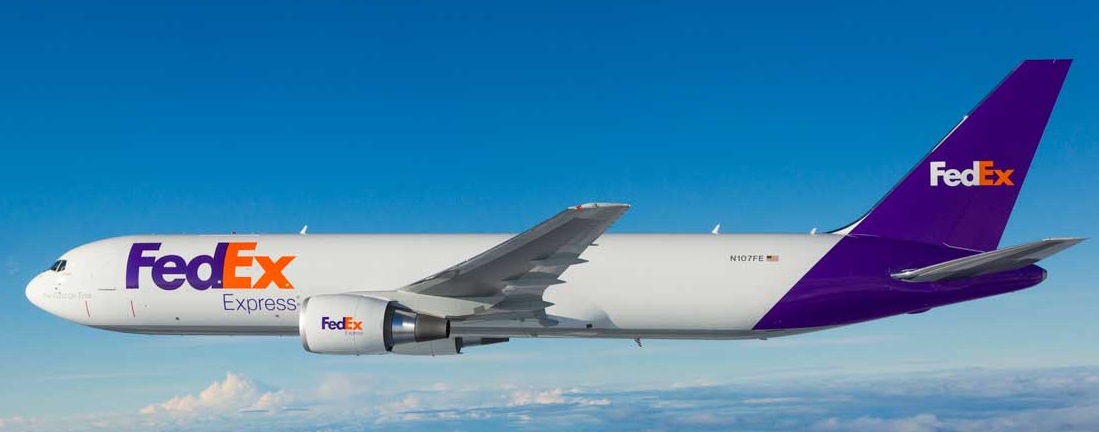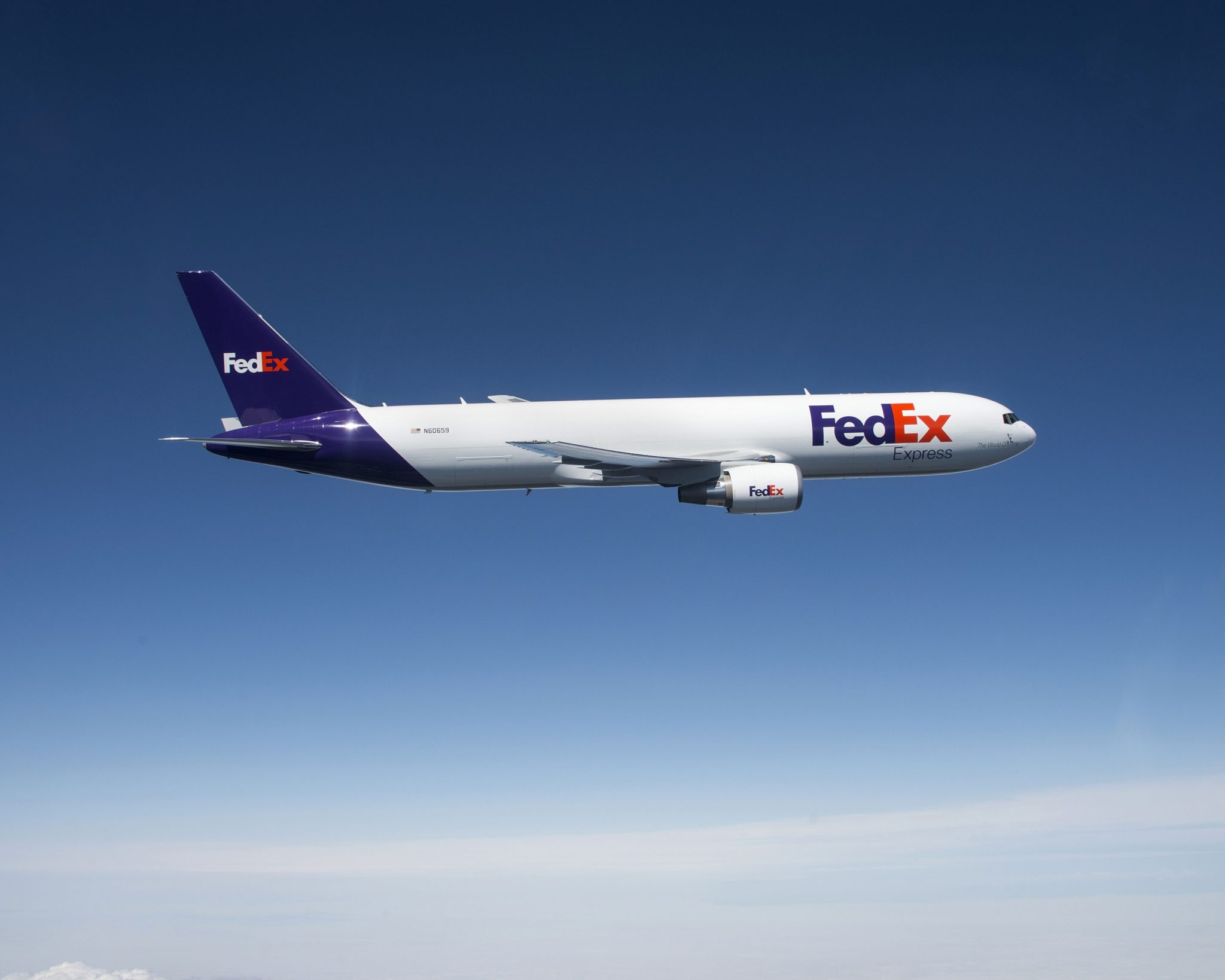Leeham News and Analysis
There's more to real news than a news release.
FAA boosts oversight of Boeing; undelivered MAX 9s have discrepancies
By the Leeham News Team
Jan. 12, 2024, © Leeham News: The Federal Aviation Administration today announced it is boosting its oversight of Boeing production and manufacturing on the 737-9 MAX.
The FAA’s been overseeing Boeing deliveries of the MAX since recertifying the airplane in November 2020. Following the discovery of production issues of the 787 in October 2020 that resulted in Boeing suspending delivery for more than a year, the FAA also assumed certification by an FAA official.
With today’s announcement, the FAA said it will add “new and significant actions to immediately increase oversight” to audit the MAX 9 production line and its suppliers to “evaluate Boeng’s compliance with its approved quality procedures.
The FAA also will increase monitoring of MAX 9 in-service events and assess the safety risks of delegated authority. The full announcement is below.
Alaska 1282 isn’t a “737 MAX” story; it’s about quality assurance at Boeing or Spirit
Update: The Federal Aviation Administration today notified Boeing it is under investigation for potentially failing to ensure the door plug was properly installed.
By Scott Hamilton
Jan. 11, 2024, © Leeham News: Alaska Airlines Flight 1282’s (AS 1282) decompression last Friday on a Boeing 737-9 MAX understandably brought new focus and doubts about the MAX program.
The MAX was grounded by the Federal Aviation Administration for 21 months after the March 2019 crash of an Ethiopian Airlines 737-8 MAX. This followed an October 2018 crash of a Lion Air MAX 8 under similar flight conditions. The two accidents were traced to the root cause of a mis-designed Maneuvering Characteristics Augmentation System, or MCAS.

Note: This data is based on October 2023 information. Full year 2023 data is not available at this writing.
When a door plug for an inactive emergency exit blew out of AS 1282 at 16,000 ft minutes after departure from Portland (OR), it meant trouble for Boeing and confidence in the MAX. Fortunately, no fatalities and only a few minor injuries resulted from the decompression. The flight returned to Portland and landed safely.
Alaska grounded its fleet of 65 MAX 9s within hours. United Airlines followed the next day. It has more MAX 9s—79—than any other airline. Shortly after United’s action, the FAA made it mandatory: the MAX 9s would remain grounded until inspections and fixes, if required, could be completed. A few other international airlines followed suit.
But as information emerged through Tuesday of this week, it became clear that this story is not a “MAX” story. It’s a story about quality assurance at Boeing or Spirit AeroSystems, the maker of the 737 fuselages and the plug door.
737 incidents prompt new scrutiny at Boeing
By the Leeham News Team
Analysis
Jan. 8, 2024, © Leeham News: Following in the footsteps of the 737 rudder bolt omission inspection just last month, we have the Jan. 5 incident on Alaska Airlines Flight 1282 in which an emergency exit plug door blew off the airplane at 16,500 ft. This may indicate another quality assurance failure at either Boeing or Spirit AeroSystems.

The door plug design used on the Boeing 737-900/900ER, 737-8-200 and 737-9. Credit: Boeing, via the National Transportation Safety Board.
We don’t know if this is a Boeing problem, a Spirit problem, a bolt manufacturer problem, or an Alaska Airlines problem. It’s way too soon in the investigation to draw conclusions. Certainly, because it’s Boeing’s name on the airplane, and especially given the MAX history, people are jumping to the conclusion that Boeing screwed up again. While this may ultimately prove true, LNA is not at all prepared to conclude today that this is the case.

Illustration of the bolt locations securing the Boeing 737-9 door plug to the airframe. Credit: Capt. Chris Brady.
The flight left Portland (OR) for Ontario (CA) about 4:30pm. Six minutes later, as the two-month-old Boeing 737 MAX 9 was climbing through 16,500 ft to cruising altitude, the inactive emergency exit plug door, aft of the wing on the left side of the plane, separated from the aircraft. Decompression followed, with an emergency descent and landing back at Portland. There were no serious injuries.

The area where the door plug and cell phones fell from Alaska Airlines Flight 1282. Credit: Google Earth, NTSB.
Boeing and Spirit have been plagued in recent years by quality “escapes.” Inspection and quality assurance may be the culprit again. The official investigation will take some time. The rapid issuance of the Emergency AD Note mandating only a one time inspection is a logical response to something having been misassembled, with the fix being to verify it is assembled per drawing. Whether this is another piece of poor workmanship not being caught by inspection remains to be seen.
The following analysis was compiled by LNA’s news team.
Outlook 2024: Embraer’s continued recovery
Subscription required
By Bjorn Fehrm
January 8, 2024, © Leeham News: Embraer was hit by a double whammy before and during COVID. The non-closure of the merger of Boeing’s and Embraer’s Commercial Aircraft Divisions and the halving of its E-Jet deliveries during COVID. The year that passed marked the recovery from the extra cost and effort of the non-merger and an increase in E-Jet deliveries and orders.
It was also a progress year for the EVE eVTOL venture, with Embraer finalizing design and starting prototype production. Despite the EVE lagging behind other programs by about a year, the customers believe it’s one the most viable programs. Eve doubles the preorders of the nearest competitors.
The past year will also be seen as the break-trough year for the KC-390, Embraer’s bet to replace the venerable Lockheed-Martin C-130 military airlifter. The customer list went from three to five, with more country air forces in serious negotiations for the KC-390.
Summary:
- The E-Jets are trending back to normal volumes with better margins.
- EVE is the best-selling eVTOL, as operators trust Embraer’s knowledge and support.
- The KC-390 is on its way to capture a big slice of the C-130 Hercules replacement marker.
Outlook 2024: Boeing needs a boring year in 2024
By Dan Catchpole
Subscription Required
Jan. 4, 2024 © Leeham News: Boeing’s priorities in 2024 are clear: get the job done on time and without drama, and don’t cause any scandals. In short, it needs a boring year. However, to do that, the aerospace giant has to overcome several obstacles.
Boeing Commercial Airplanes has to increase production rate goals, sign a new labor contract and help suppliers along. That means going against Boeing management’s cultural predilection for extracting concessions from unions and contractors.
Defense is a mess, and there’s little reason to think it will improve much this year. Several fixed-cost programs are bleeding money. Boeing is competing for three major United States Department of Defense programs, but it is not favored to win any of them. This year, leadership is expected to focus on controlling costs.
A new position of executive vice president and chief operating officer for The Boeing Co. was created last month. Stephanie Pope, previously CEO of Boeing Global Services, was named to fill this slot. She’s an unknown to some customers and hasn’t run a company approaching the size of Boeing. She’ll have to prove herself in this new position of greater responsibilities than she’s ever had.
Related Articles
- Boeing files for permits to increase capacity of Charleston 787 plant to produce 14 a month. Charleston Post and Courier.
- Charleston has room to increase 787 production. LNA, November 2020.
- 2024 will be key year for Boeing labor relations. LNA, November 2020.
Summary
- BCA has to smoothly increase production rates.
- Sign a new contract with Machinists.
- Staunch the bleeding at Boeing Defense, Space and Security.
JAL A350 ground collision is first hull loss by damage and fire of an all-composite airplane
Jan. 2, 2024, (c) Leeham News: Editor’s Note: With the ground collision (Jan. 2, 2024, Tokyo time) of a Japan Air Lines Airbus A350 and its destruction by fire, we’re reposting this article from March 2009. It was then that Boeing was in early production of the 787 and the Federal Aviation Administration was studying what Special Conditions to require in the event of a fire on a composite passenger airliner. The 787 was the first all-composite airliner and how composite of this scale would react in a fire was then mostly known. The only all-composite, large airplane fire had been that of the B-2 Stealth bomber.
Video via Times of London.
LNA spoke with airport fire officials about preparing for a composite airliner fire and we discussed the challenges the US Air Force had in putting out the B-2 fire. Fires occurred on two 787s after entry into service: a JAL aircraft that was parked at the Boston airport after a flight from Tokyo and an Ethiopian 787 parked in London. The JAL fire was traced to a battery. Airport firefighters faced challenges in putting out the fire. The airplane was heavily damaged but repaired. The Ethiopian 787 fire was traced to pinched wires creating a short at the emergency transmitter locator in the top of the fuselage. The plane was heavily damaged but repaired. The JAL A350 is the first hull loss of a composite airliner and the first by fire.
Investigators will learn all kinds of lessons from the A350 accident.
All passengers and crew on the A350 escaped. The five crew on the Japanese Coast Guard airplane involved in the collision died.
The March article is below.
Re-engining the Boeing 767, Part 3
Subscription required
By Bjorn Fehrm
December 21, 2023, © Leeham News: We are looking at a re-engine of the 767, a move that Boeing is considering to avoid a production stop after 2027. The present 767 engines don’t pass emission regulations introduced by the FAA, EASA, and other regulators for production and delivery beyond 2027.
We looked at what airframe modifications are necessary to house more efficient engines last week; now, we use our Aircraft Performance and Cost model to look at the economics of the original 767 versus a re-engined one.
Summary:
- New, more environmentally friendly engines give the 767 better fuel economics.
- The Cash Operating Costs improvement is affected by higher engine maintenance costs and higher underway and airport fees as a re-engined 767 is a heavier aircraft.
Pontifications: Pope, the enigma
Editor’s Note: This is the final week of 2023 scheduled publications for LNA. Our usual posts this week will appear on Thursday and Friday. Then we’re taking the Christmas-New Year’s week off and will resume posting on Jan. 2, 2024, provided there is no breaking news of importance during the holidays.
Dec. 19, 2023, © Leeham News: Naming Stephanie Pope to the new position of EVP and COO of The Boeing Co. raises more questions than it answers.
Pope was CEO of Boeing Global Services, the only company unit currently making a consistent profit. She was named to the new corporate-level post on Dec. 11. She immediately became the favorite to succeed president and CEO David Calhoun. Calhoun, 66, was given an extension of up to five years from Boeing’s mandatory retirement age of 65. Some press reports suggested Calhoun may retire in the next year or two.
Stan Deal, the CEO of Boeing Commercial Airplanes, and Brian West, the corporate CFO, were said to have been in contention for Calhoun’s job. But Deal, who is also an EVP of The Boeing Co., is 59. At this age, any elevation to corporate CEO was a long shot at best. Calhoun brought West into the CFO position in August 2021. He’s 54, which could have given him 10 years as CEO if Calhoun steps down next year. Pope, at age 51, has four years to age 55 and then 10 years to be CEO.
In four years, Calhoun will be 70—the outside age the Board of Directors gave him with the extension.
Why Is all this timeline business relevant? Here’s why.
Bjorn’s Corner: New aircraft technologies. Part 42. Improving the learning curve
December 15, 2023, ©. Leeham News: We are discussing the different phases of a new airliner program. After covering Conceptual, Preliminary, and Detailed design, the manufacturing of prototypes, and their roles in flight tests, we now look at the production phase.
Last week, we discussed why production costs vary over time and why they can be up to 500% higher for the first units than for units past 400 to 500 aircraft produced. Now we go deeper into the reasons behind this and what can be done to improve the situation.
Re-engining the Boeing 767, Part 2
Subscription required
By Bjorn Fehrm
December 14, 2023, © Leeham News: We are looking at a re-engine of the 767, a move that Boeing is considering to avoid a production stop after 2027. The present 767 engines don’t pass emission regulations introduced by FAA, EASA, and other regulators for production and delivery beyond 2027.
We have described the history of the 767 and the key data of the different variants in last week’s article. Now, we look at what airframe modifications are necessary to house more efficient engines and what consequences these bring.
Summary:
- New, more environmentally friendly engines for the 767 mean changes to the landing gear and structures to house larger and heavier engines.
- For the payload capacity to stay the same a deeper grab in the 767-400 toolbox is necessary than just adopting the landing gear.








